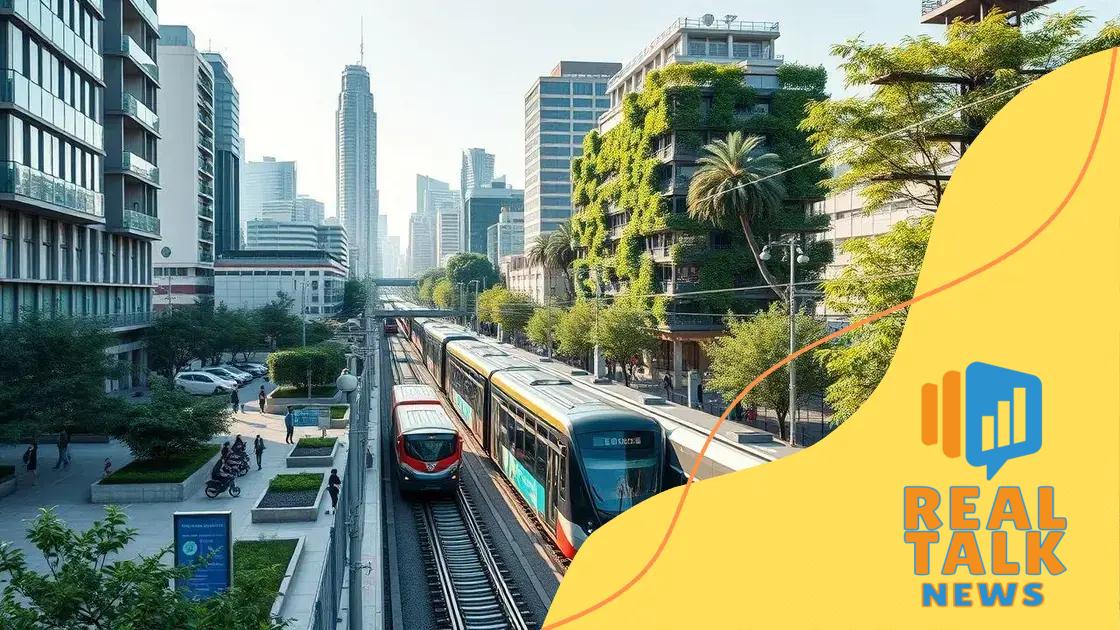How smart cities are improving urban sustainability

Smart cities improve urban sustainability by utilizing green infrastructure, smart technologies, and community engagement to enhance resource management and reduce waste, fostering a healthier and more efficient urban environment.
How smart cities are improving urban sustainability is a topic that sparks curiosity about our future urban environments. Have you ever wondered how technology can transform cities into greener, more efficient spaces? Let’s explore this fascinating evolution.
Understanding smart cities and sustainability
Understanding smart cities and sustainability is vital in today’s world. As cities grow, finding ways to enhance urban living while protecting the environment becomes crucial. Smart cities utilize technology to improve infrastructure, making them more efficient and eco-friendly.
What Are Smart Cities?
Smart cities are urban areas that use digital technology to enhance performance in various sectors, including energy, transportation, and water management. By leveraging data, cities can optimize resources, reduce waste, and create better living conditions for residents.
How They Promote Sustainability
One way smart cities promote sustainability is through energy-efficient buildings that reduce energy consumption. Advanced sensors and smart grids allow for better energy management, which leads to lower carbon emissions. Moreover, these cities often incorporate renewable energy sources, such as solar and wind power.
- Use of smart meters for real-time energy tracking
- Integration of electric vehicles to reduce pollution
- Implementation of green roofs and urban gardens
Additionally, smart transportation systems decrease traffic congestion. By utilizing technologies like real-time traffic monitoring, cities can reduce travel time and cut emissions. Public transportation in smart cities is often enhanced with mobile applications that inform users about the best routes, making it a more attractive option.
The Role of Data
Data plays a crucial role in understanding how smart cities function. Through the collection of data on air quality, traffic patterns, and energy usage, city planners can make informed decisions to improve urban life. Big data analytics allow for real-time adjustments to the city’s operations, leading to significant enhancements in sustainability practices.
This data not only helps in daily management but also in long-term planning. By understanding trends and patterns, smart cities can develop strategies that address future challenges while promoting a sustainable environment.
Benefits of Smart Cities
Adopting smart technologies leads to numerous benefits:
- Enhanced public health through cleaner air and increased green spaces
- Improved quality of life with better services and amenities
- Economic growth through increased efficiency and innovation
As we explore how smart cities are reshaping urban living, it becomes clear that they are not just a trend but a necessary step towards a sustainable future. By embracing technology, these cities are setting the pace for urban development that prioritizes both people and the planet. This journey towards sustainability is not without challenges, yet the potential benefits make it worth pursuing.
Key technologies driving urban sustainability
Key technologies driving urban sustainability include innovations that enhance resource management and promote eco-friendly practices. These tools play a significant role in transforming how cities operate and interact with their environments. Incorporating smart technologies is essential for creating sustainable urban landscapes.
Internet of Things (IoT) in Cities
The Internet of Things (IoT) connects devices across the city, allowing for real-time data collection and analysis. This technology helps monitor everything from energy use to air quality. Cities can make rapid improvements based on this data, improving residents’ quality of life.
Renewable Energy Sources
Utilizing renewable energy sources is crucial for sustainability. Solar panels, wind turbines, and geothermal energy systems are being implemented in urban areas. These technologies reduce dependency on fossil fuels and lower carbon emissions. Additionally, some cities are investing in energy storage systems to maximize the efficiency of renewable energy.
- Solar energy systems on rooftops
- Wind farms in urban spaces
- Smart grids for energy distribution
Transportation is another key area where technology drives sustainability. Cities are increasingly adopting electric vehicles (EVs) and charging infrastructure. With fewer emissions compared to traditional vehicles, EVs contribute significantly to cleaner air quality.
Smart Water Management
Water is a precious resource, and technology can aid in its management. With smart water sensors and monitoring systems, cities can detect leaks and inefficiencies in their water supply. These technologies help reduce water waste while ensuring that communities have access to clean water.
In addition to smart water management, green infrastructure such as rain gardens and permeable pavements can help manage stormwater effectively. This approach not only reduces flooding but also improves water quality.
Data Analytics and AI
Data analytics and artificial intelligence (AI) are revolutionizing urban management. By collecting and interpreting large amounts of data, cities can forecast trends and make informed decisions. This technology allows for better planning and resource allocation, further promoting sustainability.
Through these technologies, cities are evolving into smarter, more efficient urban spaces that prioritize sustainability. As more urban areas adopt these innovations, the potential for creating greener cities increases significantly.
Case studies of successful smart cities

Case studies of successful smart cities provide insight into how technology can transform urban environments. These examples showcase the benefits and innovations that result from implementing smart solutions. Cities like Barcelona, Singapore, and Medellín are leading the way in sustainable urban development.
Barcelona’s Smart City Initiatives
In Barcelona, various initiatives have made it a model for smart urban living. The city implemented a network of sensors to monitor everything from traffic patterns to waste management. This IoT technology has significantly improved operational efficiency.
Today, residents benefit from:
- Smart lighting systems that automatically adjust to daylight
- Real-time public transport updates through mobile apps
- Efficient waste collection, optimizing routes based on sensor data
Barcelona’s efforts have led to reduced energy consumption and improved overall quality of life.
Singapore and Its Integrated Approach
Singapore is renowned for its comprehensive smart city strategy. The government focuses on a data-driven approach, utilizing analytics to manage urban challenges. The implementation of smart traffic lights and extensive surveillance systems helps to ease congestion and enhance safety.
Additionally, Singapore has pioneered:
- Green buildings that achieve high energy efficiency
- Smart water management systems to prevent flooding
- Public initiatives encouraging sustainable living among residents
These innovations have increased the city’s resilience against climate change and improved urban sustainability.
Medellín’s Transformation
Medellín, once known for its struggles, has turned into a success story of transformation. The city invested in smart public transport systems and urban development projects that promote social inclusion. The Metrocable system connects underserved areas to the city center.
Medellín is also known for:
- Innovative public spaces that foster community engagement
- Smart energy solutions that reduce costs
- Urban gardens that enhance food security and promote green spaces
This comprehensive approach has not only revolutionized public transport but has also contributed to improved social equity.
These case studies illustrate the practical benefits of smart city technologies. Integrating these innovations leads to more resilient and sustainable urban spaces, showcasing that positive change is possible through collective effort.
Challenges faced in implementing smart city initiatives
Challenges faced in implementing smart city initiatives are significant and can impact the success of these ambitious projects. While the benefits of becoming a smart city are clear, many obstacles must be navigated to achieve these goals. From funding to public acceptance, each challenge plays a critical role in shaping the outcome of smart city plans.
Funding and Budget Constraints
One of the primary challenges is securing sufficient funding. Smart city projects often require large investments in technology and infrastructure. Many cities operate under tight budgets, making it difficult to allocate funds for these innovations. Without financial backing, even the best ideas can stall before they begin.
- Lack of government grants or public-private partnerships
- High costs associated with technology and training
- Overcoming traditional budgeting processes
Municipalities must explore diverse funding sources to overcome this hurdle, including grants, private investment, or collaboration with tech companies.
Data Privacy and Security Concerns
As cities become smarter, they collect vast amounts of data, raising significant concerns around privacy and security. Citizens may worry about how their data is being used and whether it is adequately protected. Ensuring transparency and building trust is essential for successful smart city initiatives.
Municipalities need to establish clear regulations and practices regarding data management. This includes:
- Implementing strict data management policies
- Educating the public on data usage
- Using advanced cybersecurity measures to protect information
Public Engagement and Acceptance
Public acceptance is another major challenge. Many residents may not fully understand the benefits of smart city initiatives. Without community support, projects are less likely to succeed. Cities must actively engage their populations to raise awareness and gather feedback.
Strategies to boost public engagement can include:
- Hosting community forums to discuss smart city plans
- Providing educational programs about smart technologies
- Encouraging participation in pilot projects
By creating a dialogue with citizens, cities can better address concerns and foster a sense of ownership in smart city initiatives.
Integration of Technologies
Integrating diverse technologies and systems can also be a complex task. Many cities rely on outdated infrastructure, making it challenging to implement new technology seamlessly. Upgrading existing systems requires careful planning and execution.
Collaborating with technology providers is critical to ensure that the various systems work together efficiently. Strong project management can help to prevent disruptions and ensure a smoother transition to smart systems.
Recognizing and addressing these challenges is crucial for cities aiming to implement successful smart city initiatives. By taking a proactive approach and collaborating with stakeholders, cities can navigate these hurdles effectively and build a brighter, sustainable future.
Future trends in urban sustainability
Future trends in urban sustainability are shaping the way cities will grow and evolve. As environmental challenges become more pressing, urban planners are increasingly focusing on innovative approaches to ensure sustainable growth. By leveraging technology and engaging communities, cities can create smarter, greener environments.
Green Infrastructure Development
One key trend is the expansion of green infrastructure. This includes parks, green roofs, and urban gardens that not only enhance the aesthetic appeal of a city but also improve air quality and promote biodiversity. As urban areas continue to grow, integrating nature into the built environment becomes vital.
Green infrastructure can offer:
- Natural solutions for managing stormwater
- Improved urban heat resilience
- Space for recreation and physical activity
Smart Technologies and Data-Driven Decisions
The rise of smart technologies will also shape future urban sustainability. Cities are increasingly using data collected from various sensors to make informed decisions about resource management, transportation, and energy use. By analyzing this data, cities can optimize their operations and improve the quality of life for their residents.
Applications include:
- Traffic management systems for reducing congestion
- Smart energy grids for efficient resource distribution
- Waste management solutions that decrease landfill use
This data-driven approach enables cities to respond quickly to emerging issues and adapt to changing conditions.
Community Engagement and Resilience Planning
Another important trend is the emphasis on community engagement. Cities recognize that involving residents in planning and decision-making leads to better outcomes. Community-led initiatives foster a sense of ownership and responsibility, crucial for long-term sustainability.
Key components of community engagement include:
- Workshops and forums to gather public input
- Collaborative projects that encourage volunteerism
- Education programs promoting sustainability practices
This collaborative approach not only improves urban resilience but also strengthens community bonds.
Focus on Circular Economy
Adopting a circular economy mindset is also gaining traction. This approach focuses on minimizing waste and promoting the continual use of resources. By prioritizing recycling and reuse, cities can reduce their environmental impact while stimulating economic growth.
This involves:
- Encouraging businesses to adopt sustainable practices
- Developing systems for recycling and composting
- Promoting products designed for durability and ease of repair
As cities embrace these future trends, the potential for improving urban sustainability becomes more attainable. By integrating innovative practices and collaborating with communities, urban areas can evolve into sustainable hubs that support both people and the planet.
In conclusion, the future of urban sustainability is bright, driven by innovative practices and community involvement. As cities focus on green infrastructure, smart technologies, and circular economy principles, they are not just improving their environments but also enhancing the quality of life for residents. It is essential for stakeholders to work together, ensuring that sustainability becomes a key focus in urban development. With ongoing efforts and collaboration, cities can evolve into healthier, smarter places for everyone.
FAQ – Frequently Asked Questions about Urban Sustainability
What is green infrastructure?
Green infrastructure refers to natural processes that help manage stormwater, improve air quality, and enhance urban aesthetics by integrating parks, green roofs, and urban gardens.
How do smart technologies improve cities?
Smart technologies utilize data from sensors to optimize city services like traffic management, waste collection, and energy use, leading to enhanced efficiency and quality of life.
Why is community engagement important in smart city initiatives?
Community engagement ensures that residents have a voice in decision-making, fostering a sense of ownership and responsibility, which is critical for the success of urban sustainability projects.
What is a circular economy?
A circular economy focuses on minimizing waste by encouraging the reuse and recycling of resources, promoting sustainable practices that keep materials in use for as long as possible.





